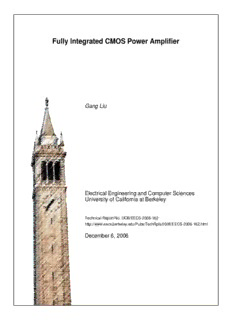
Fully Integrated CMOS Power Amplifier PDF
Preview Fully Integrated CMOS Power Amplifier
Fully Integrated CMOS Power Amplifier Gang Liu Electrical Engineering and Computer Sciences University of California at Berkeley Technical Report No. UCB/EECS-2006-162 http://www.eecs.berkeley.edu/Pubs/TechRpts/2006/EECS-2006-162.html December 6, 2006 Copyright © 2006, by the author(s). All rights reserved. Permission to make digital or hard copies of all or part of this work for personal or classroom use is granted without fee provided that copies are not made or distributed for profit or commercial advantage and that copies bear this notice and the full citation on the first page. To copy otherwise, to republish, to post on servers or to redistribute to lists, requires prior specific permission. Fully Integrated CMOS Power Amplifier by Gang Liu B.E. (Tsinghua University) 1998 A dissertation submitted in partial satisfaction of the requirements for the degree of Doctor of Philosophy in Engineering - Electrical Engineering and Computer Sciences in the GRADUATE DIVISION of the UNIVERSITY OF CALIFORNIA, BERKELEY Committee in charge: Professor Ali M. Niknejad, Co-chair Professor Tsu-Jae King Liu, Co-chair Professor Peidong Yang Fall 2006 The dissertation of Gang Liu is approved: ----------------------------------------------------------------------------------- Co-chair Date ----------------------------------------------------------------------------------- Co-chair Date ----------------------------------------------------------------------------------- Date UNIVERSITY OF CALIFORNIA, BERKELEY Fall 2006 Fully Integrated CMOS Power Amplifier Copyright 2006 by Gang Liu Abstract Fully Integrated CMOS Power Amplifier by Gang Liu Doctor of Philosophy in Electrical Engineering and Computer Sciences University of California, Berkeley Professor Ali M. Niknejad, Co-chair Professor Tsu-Jae King Liu, Co-chair Today’s consumers demand wireless systems that are low-cost, power efficient, reliable and have a small form-factor. High levels of integration are desired to reduce cost and achieve compact form factor for high volume applications. Hence the long term vision or goal for wireless transceivers is to merge as many components as possible, if not all, to a single die in an inexpensive technology. Therefore, there is a growing interest in utilizing CMOS technologies for RF power amplifiers (PAs). Although several advances have been made recently to enable full integration of PAs in CMOS, it is still among the most difficult challenges in achieving a truly single-chip radio system in CMOS. This is exacerbated by supply voltage reduction due to CMOS technology scaling and on-chip passive losses due to the conductive substrate used in deep submicron CMOS processes. 1 Efficiency is one of the most important metrics in the design of power amplifiers. Conventional designs give maximum efficiency only at a single power level, usually near the maximum rated power for the amplifier. As the output power is backed off from that single point, the efficiency drops rapidly. However, power back-off is inevitable in today’s wireless communication systems. To date, there has been relatively little research on the design of a CMOS PA targeting good average efficiency. A new transformer combining architecture, which is suitable in designing highly efficient PAs in CMOS processes, is proposed to address this issue. A prototype was implemented with only thin-oxide transistors in a 0.13-µm RF- CMOS process to demonstrate the concept. Experimental results validate our concept and demonstrate the feasibility of highly efficiency, fully integrated power amplifiers in CMOS technologies. ---------------------------------------------------------- Professor Ali M. Niknejad Dissertation Committee Co-chair ---------------------------------------------------------- Professor Tsu-Jae King Liu Dissertation Committee Co-chair 2 Contents Chapter 1: Introduction.......................................................................................................1 1.1 Recent developments of wireless communication technologies...............................1 1.2 Motivation.................................................................................................................6 1.3 Overview of the work and its contribution...............................................................9 1.4 Organization of the thesis.......................................................................................11 1.5 References...............................................................................................................12 Chapter 2: Fundamentals of Power Amplifiers................................................................16 2.1 An overview of classifications and specifications of PAs......................................16 2.1.1 Class-A, AB, B, and C power amplifiers.........................................................16 2.1.2 Class-D power amplifiers................................................................................18 2.1.3 Class-E power amplifiers.................................................................................18 2.1.4 Class F power amplifiers.................................................................................20 2.1.5 Class-G and Class-H power amplifiers............................................................20 2.1.6 Class-S power amplifiers.................................................................................21 2.1.7 Hybrid class power amplifiers.........................................................................21 2.1.8 Performance metrics of power amplifiers........................................................22 2.2 Efficiency of Power Amplifiers..............................................................................22 2.3 Linearity of Power Amplifiers................................................................................30 2.3.1 AM-AM Conversion........................................................................................31 2.3.2 AM-PM Conversion.........................................................................................33 2.3.3 Adjacent Channel Power Ratio (ACPR)..........................................................34 2.3.4 Spectral MASK................................................................................................35 2.3.5 Error Vector Magnitude (EVM)......................................................................36 2.3.6 Linearization Techniques.................................................................................38 2.4 Summary.................................................................................................................39 2.5 References...............................................................................................................39 Chapter 3: CMOS Technology for RF Power Amplifiers................................................42 3.1 Prevalent Technologies for RF Power Amplifiers..................................................42 3.1.1 GaAs HBT Technology...................................................................................42 3.1.2 GaAs MESFET Technology............................................................................44 3.1.3 GaAs HEMT Technology................................................................................45 3.1.4 Si CMOS Technology......................................................................................48 3.1.5 SiGe HBT Technology....................................................................................51 3.1.6 Si LDMOS Technology...................................................................................53 3.2 Comparisons among Prevalent Technologies.........................................................54 3.2.1 Substrate...........................................................................................................56 i 3.2.2 Backside Vias...................................................................................................57 3.2.3 Passives............................................................................................................58 3.2.3 Device characteristics......................................................................................61 3.2.4 Manufacturing Cost.........................................................................................64 3.2.5 Integration........................................................................................................66 3.2.6 Availability & Capacity...................................................................................66 3.3 Trends of Supply Voltages for Portable Devices....................................................67 3.4. Limits of CMOS and the Impact of Scaling..........................................................72 3.4.1 Device Scaling.................................................................................................72 3.4.2 Starting Materials.............................................................................................74 3.4.3 Metal Stack Scaling.........................................................................................74 3.5 Summary.................................................................................................................75 3.6 References...............................................................................................................76 Chapter 4: Generating High Power with Low Voltage Devices.......................................80 4.1 Series Power Combining.........................................................................................80 4.1.1 Cascode Configuration.....................................................................................80 4.1.2 Totem-Pole Technique.....................................................................................83 4.1.3 Stacked Transistors Amplifier.........................................................................84 4.2 Parallel Combining.................................................................................................85 4.2.1 Transformer Based Power Combining.............................................................85 4.2.2 Transmission Line Based Power Combining...................................................88 4.3 Proposed Power Combiner.....................................................................................94 4.3.1 Power Combining Transformer.......................................................................94 4.4 Summary...............................................................................................................114 4.5 References.............................................................................................................115 Chapter 5. The Power Combining Transformer Design.................................................118 5.1 Impedance Transformation...................................................................................118 5.1.1 LC Resonant Matching Network...................................................................119 5.1.2 Transformer Matching Network....................................................................123 5.2 Design Considerations of Transformers for Power Amplifiers............................129 5.2.1 Low Impedance Inductor Design...................................................................131 5.2.2 Low Turn Ratio Transformer Design............................................................136 5.3 Design and Implementation of the Proposed Transformer...................................139 5.4 Discussions and Summary....................................................................................143 5.5 References.............................................................................................................146 Chapter 6. A Fully Integrated CMOS Power Amplifier with Average Efficiency Enhancement...................................................................................................................148 6.1 Design of the Prototype........................................................................................149 6.1.1 Features of the CMOS Process......................................................................149 6.1.2 PA Architecture.............................................................................................149 6.1.3 Power Combining..........................................................................................150 6.1.4 Pseudo-Differential Pair.................................................................................151 6.1.5 Transconductor Design..................................................................................152 6.1.6 Cascode Transistor Design............................................................................155 ii 6.1.7 Output Matching Network – Transformer Power Combiner.........................157 6.1.8 Stability..........................................................................................................160 6.2 Layout Considerations..........................................................................................162 6.2.1 Transconductor Layout..................................................................................162 6.2.2 Cascode Transistor Layout............................................................................165 6.3 The CMOS Prototype...........................................................................................166 6.4 Experimental Results............................................................................................170 6.4.1 CW Signal Test..............................................................................................171 6.4.2 Modulated Signal Test...................................................................................174 6.5 Summary...............................................................................................................177 6.6 References.............................................................................................................177 Chapter 7. Conclusion.....................................................................................................179 7.1 Thesis Summary....................................................................................................179 7.2 Possible Future Directions....................................................................................181 iii
Description: